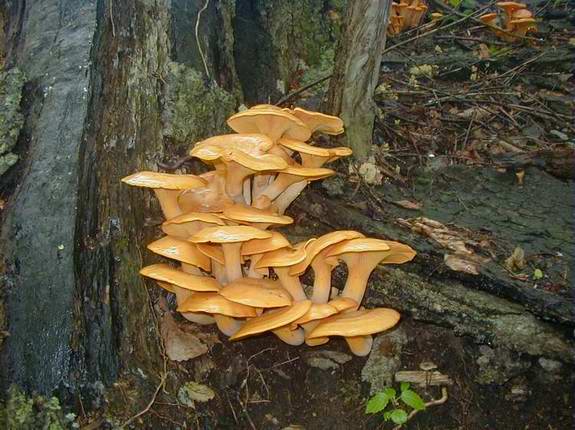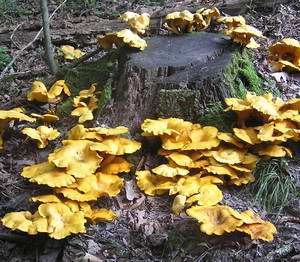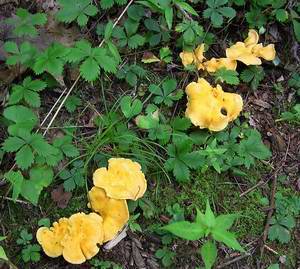|
Return to Hiker's Notebook Home Page
Common Name: Jack O'Lantern, False Chanterelle - The term Jack O'Lantern is an obsolete term for a man with a lantern - a night watchman. It is synonymous with ignis fatuus (Latin for 'foolish fire'), one of the names for the luminous swamp gas sometimes called 'will-o'-the-wisp.' The name is more prominently associated with the carved and illuminated Halloween pumpkin. It refers here to the fact that the mushroom glows in the dark.
Scientific Name: Omphalotus illudens - The generic name is from the Greek omphalos which means navel, probably in reference to the long, tapering, umbilical stem. The specific name is likely from the Latin illudere, to mock or jeer, which is taken to mean deception in similar fashion to its association as the root for the word illusion. Also known as O. olearius and Clitocybe illudens.
The jack-o-lantern-like glow of O. illudens known as bioluminescence is its most well-known and most controversial feature. The quantity and quality of its light is highly subjective to the age and habitat of the mushroom, to the mode of storage if picked and to the time and location of light observation. If you pick a young mushroom and observe it in a very dark place, the gills will glow with a faint green hue. Michael Kuo (mushroomexpert.com) declared the illumination as the "largest and most insidious conspiracy in the mycological world," though he subsequently issued a corrigendum that the degree of light was dependent on whether the mushroom was kept moist after picking. In The Complete Mushroom Hunter, Gary Lincoff states that the "light can be so bright that you can read a newspaper" and that they have been used to mark a path in the woods at night. Bill Russell in the Field Guide to Wild Mushrooms of the Mid-Atlantic proffers that the glow can be sustained by storing the mushrooms in a paper bag in the refrigerator to retain the moisture and reduce the oxidation rate during the day and bringing them out for a light show at night. The more creative if outr� David Aurora tells the tale in Mushrooms Demystified of a shipwrecked sailor who wrote his last message with the light from a jack-o-lantern using the ink from a shaggy mane and a pen made from an agaric, only to die of starvation because he was afraid to eat the mushrooms, certainly an apocryphal fabrication.
It is not likely that the Jack O'Lantern would have helped the sailor very much, as they are widely, though not universally, listed as poisonous; the most commonly listed symptoms are vomiting and diarrhea for several days after ingestion. According to Tom Volk, the noted mycologist from the University of Wisconsin, "Omphalotus olearius won't kill you - it will just make you wish you were dead." However, Charles McIlvane tells a different story in One Thousand American Fungi, which was originally published in 1900 and was for many years the preeminent North American reference; it has a stated raison d'�tre for the promotion of eating toadstools (in McIlvane's words). His description concerning the Jack O'Lantern is that "strong stomachs can retain a meal of them" and that the taste is "rather saponaceous" which is to say soapy. Further, he quotes a certain H. I. Miller of Indiana who testifies that "I have several times eaten of it without other than pleasurable sensations."
However, the Jack O'Lantern is now considered to be one of the mushrooms most
often implicated in poisoning. This is because of several factors: they are
found in large quantities in clumps growing conspicuously on wood; they are
very easy to find due their bright orange-yellow hue; they have an appealing
aroma; and, most importantly, they bear a not inconsequential resemblance to
among the most common of the choice edible mushrooms - the
chanterelles (Chantarellus spp).
The similarities are that they are about the same color, they both have the
same basic cup or horn-like shape, and they can both be found growing on the
ground. Chanterelles, however,
There are three species of Jack O'Lantern that are distinguished mostly by their geographical dispersion, as they have fairly superficial physical differences. O. olivascens, which is indigenous to western North America, is described as having either a brownish or golden-olive color and O. olearius (from the Latin olea meaning olive tree) is native to Europe (and grows on olive trees) and is not distinguishable from O. illudens, the eastern North American variant. Since they all glow in the dark and they are all poisonous, it is not unreasonable to consider that the different species of Jack O'Lantern are really one and the same. There is also an Asian variant (O. japonicus) known in Japan as tsukiyotake that has been verified as a relative of the Jack O'Lantern.
The poisonous compounds of the Jack O'Lantern mushrooms have been isolated and identified as a family of sesquiterpenes (hydrocarbon terpene compounds that have a two to three ratio of primary radicals) that have been named illudens. Research conducted at the University of California in San Diego in the 1990's revealed that illudens are toxic to tumor cells in general with long exposure times and selectively to those of myelocytic leukemia as well as lung, ovarian and breast carcinoma cells with shorter exposure times. Since the naturally occurring Jack O'Lantern illudin compounds have been found to be too toxic for humans, a synthetic version is being developed. Irofulven (also known as HMAF of MGI-114) is being tested by MGI Pharma as a possible drug for the treatment of ovarian, prostate, liver, breast, lung and colon cancers.
Bioluminescence is not all that uncommon among plants and animals; it is estimated that about 90 percent of deep-ocean marine life produce some light. The mechanism of light production is chemical and involves a reaction between a type of small molecule pigment named luciferin and oxygen in the presence of an enzyme called luciferase. The names of both the pigment and the enzyme derive from lucifer, which means "light-bearer" in Latin and originally was used to refer to the appearance of the planet Venus in the morning sky. Its association with the devil in Christian parlance is based on a passage in the book of Isaiah that refers to a "day star" fallen from heaven - a fallen angel. The oxidation of luciferin to produce light is nearly 100 percent efficient in that it produces almost no heat and is accordingly called cold light. The use of bioluminescence in plants and animals is generally thought to involve either protection or survival. However, for the fungi and bacteria the purpose is not so clear. It is thought that it may have evolved to remove oxygen when it may have been harmful to the organism. Another theory for fungi is that it attracts nocturnal insects that assist in spore dispersal. |


 can be distinguished by several features: they have ridges or folds instead of
gills on the underside of the cap (pileus); they grow singly on the ground;
the cap has a irregularly shaped or wavy edge; and they have an aroma that is
similar to apricot. To someone with fungi field experience, the differences
can be readily discerned, even from a distance. However, some Jack O'Lantern
mushrooms grow on the ground drawing nutrients from tree roots and some
chanterelles have ridges that look a lot like gills. And both mushrooms have a
pleasant aroma. The top photo is the jack-o-lantern and the bottom is a
chanterelle. Michael Pollan writes of his identification problems with his
first wild chanterelle. His conclusion is that: "I didn't realize it at the
time, but I had impaled myself that afternoon on the horn's of the omnivore's
dilemma" which is that eating can be dangerous and that "when it comes to
figuring out which of those things are safe to eat, he's pretty much on his
own." One may therefore conclude that eating wild mushrooms is the
quintessential Omnivore's Dilemma (which is of course the title of the
book).
can be distinguished by several features: they have ridges or folds instead of
gills on the underside of the cap (pileus); they grow singly on the ground;
the cap has a irregularly shaped or wavy edge; and they have an aroma that is
similar to apricot. To someone with fungi field experience, the differences
can be readily discerned, even from a distance. However, some Jack O'Lantern
mushrooms grow on the ground drawing nutrients from tree roots and some
chanterelles have ridges that look a lot like gills. And both mushrooms have a
pleasant aroma. The top photo is the jack-o-lantern and the bottom is a
chanterelle. Michael Pollan writes of his identification problems with his
first wild chanterelle. His conclusion is that: "I didn't realize it at the
time, but I had impaled myself that afternoon on the horn's of the omnivore's
dilemma" which is that eating can be dangerous and that "when it comes to
figuring out which of those things are safe to eat, he's pretty much on his
own." One may therefore conclude that eating wild mushrooms is the
quintessential Omnivore's Dilemma (which is of course the title of the
book).